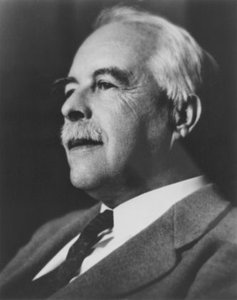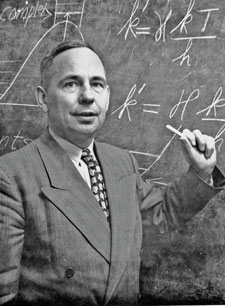Related Research Articles

Gilbert Newton Lewis was an American physical chemist and a dean of the college of chemistry at University of California, Berkeley. Lewis was best known for his discovery of the covalent bond and his concept of electron pairs; his Lewis dot structures and other contributions to valence bond theory have shaped modern theories of chemical bonding. Lewis successfully contributed to chemical thermodynamics, photochemistry, and isotope separation, and is also known for his concept of acids and bases. Lewis also researched on relativity and quantum physics, and in 1926 he coined the term "photon" for the smallest unit of radiant energy.

A timeline of events in the history of thermodynamics.

Henry Eyring was a Mexico-born United States theoretical chemist whose primary contribution was in the study of chemical reaction rates and intermediates. Eyring developed the Absolute Rate Theory or Transition state theory of chemical reactions, connecting the fields of chemistry and physics through atomic theory, quantum theory, and statistical mechanics.
The year 1911 in science and technology involved some significant events, listed below.
The year 1916 involved a number of significant events in science and technology, some of which are listed below.
The year 1942 in science and technology involved some significant events, listed below.

Rudolph Arthur Marcus is a Canadian-born American chemist who received the 1992 Nobel Prize in Chemistry "for his contributions to the theory of electron transfer reactions in chemical systems". Marcus theory, named after him, provides a thermodynamic and kinetic framework for describing one electron outer-sphere electron transfer. He is a professor at Caltech, Nanyang Technological University, Singapore and a member of the International Academy of Quantum Molecular Science.
The year 1954 in science and technology involved some significant events, listed below.
The year 1956 in science and technology involved some significant events, listed below.
The year 1947 in science and technology involved some significant events, listed below.
The year 1943 in science and technology involved some significant events, listed below.
The year 1941 in science and technology involved some significant events, listed below.

Sir Robert Robinson was a British organic chemist and Nobel laureate recognised in 1947 for his research on plant dyestuffs (anthocyanins) and alkaloids. In 1947, he also received the Medal of Freedom with Silver Palm.

Nikolay Nikolayevich Bogolyubov, also transliterated as Bogoliubov and Bogolubov, was a Soviet and Russian mathematician and theoretical physicist known for a significant contribution to quantum field theory, classical and quantum statistical mechanics, and the theory of dynamical systems; he was the recipient of the 1992 Dirac Medal.
In statistical physics, the BBGKY hierarchy (Bogoliubov–Born–Green–Kirkwood–Yvon hierarchy, sometimes called Bogoliubov hierarchy) is a set of equations describing the dynamics of a system of a large number of interacting particles. The equation for an s-particle distribution function (probability density function) in the BBGKY hierarchy includes the (s + 1)-particle distribution function, thus forming a coupled chain of equations. This formal theoretic result is named after Nikolay Bogolyubov, Max Born, Herbert S. Green, John Gamble Kirkwood, and Jacques Yvon.
The year 1931 in science and technology involved some significant events, listed below.
The 1851 Research Fellowship is a scheme conducted by the Royal Commission for the Exhibition of 1851 to annually award a three-year research scholarship to approximately eight "young scientists or engineers of exceptional promise". The fellowship is open to all nationalities and fields of science, including physical or biological sciences, mathematics, applied science, and any branch of engineering. The fellowship can be held anywhere in the United Kingdom.

Louis Edward Brus is an American chemist, and currently the Samuel Latham Mitchell Professor of Chemistry at Columbia University. He is the co-discoverer of the colloidal semi-conductor nanocrystals known as quantum dots. In 2023, he was awarded the Nobel Prize in Chemistry.
References
- ↑ Daly, Reginald A. (1946). "Origin of the Moon and Its Topography". Proceedings of the American Philosophical Society . 90 (2): 104–19. JSTOR 3301051.
- ↑ Österreichische Zoologische Zeitschrift1: pp. 1–48.
- ↑ Jaeger, Edmund C. (May–June 1949). "Further Observations on the Hibernation of the Poor-will". The Condor . 3. 51 (3): 105–109. doi:10.2307/1365104. ISSN 0010-5422. JSTOR 1365104. OCLC 478309773.
Earlier I gave an account (Condor, 50, 1948:45) of the behavior of a Poor-will (Phalaenoptilus nuttallinii) which I found in a state of profound torpidity in the winter of 1946–47 in the Chuckawalla Mountains of the Colorado Desert, California.
(photographs by Kenneth Middleham) - ↑ Hiltner, Nita (2011-02-20). "A Look Back". The Press-Enterprise . Riverside, California: Enterprise Media. Archived from the original on January 31, 2013. Retrieved 2011-11-15.
- ↑ Chamberlin, Wellman (1947). The Round Earth on Flat Paper: Map Projections Used by Cartographers. Washington, D.C.: National Geographic Society. ASIN B000WTCPXE.
- ↑ Robinson, R. (1946). "The constitution of strychnine". Experientia. 2 (1): 1946. doi:10.1007/BF02154708. PMID 21012825.
- ↑ Briggs, L. H.; Openshaw, H. T.; Robinson, Robert (1946). "Strychnine and brucine. Part XLII. Constitution of the neo-series of bases and their oxidation products". Journal of the Chemical Society . London: 903. doi:10.1039/JR9460000903.
- ↑ Openshaw, H. T.; Robinson, R. (1946). "Constitution of Strychnine and the Biogenetic Relationship of Strychnine and Quinine". Nature. 157 (3988): 438. Bibcode:1946Natur.157..438O. doi: 10.1038/157438a0 . PMID 21024272.
- ↑ "1946." Britannica.
- ↑ "Computing timeline". The Centre for Computing History . Retrieved 2012-01-29.
- ↑ Berkson, Joseph (June 1946). "Limitations of the Application of Fourfold Table Analysis to Hospital Data". Biometrics Bulletin . 2 (3): 47–53. doi:10.2307/3002000. JSTOR 3002000. PMID 21001024.
- ↑ Meisol, Patricia (17 March 1998). "Echoes from the baby boom appreciation: for 50 years, parents turned to the book by Dr. Benjamin Spock for the most common-sense advice about raising children". The Baltimore Sun . Archived from the original on 2010-05-16. Retrieved 2010-03-31.
- ↑ Roach, Mary (2007-03-18). "Girls Will Be Boys". The New York Times . Archived from the original on July 14, 2012. Retrieved 2007-03-25.
- ↑ Gilman, Alfred; Philips, Frederick S. (5 April 1946). "The Biological Actions and Therapeutic Applications of the Β-Chloroethyl Amines and Sulfides". Science . 103 (2675): 409–15, 436. Bibcode:1946Sci...103..409G. doi:10.1126/science.103.2675.409. JSTOR 1673195. PMID 17751251.
- ↑ Gilman, Alfred (1963). "The Initial Clinical Trial of Nitrogen Mustard". American Journal of Surgery. 105 (5): 574–578. doi:10.1016/0002-9610(63)90232-0. PMID 13947966.
- ↑ Bogoliubov, N. N. (1946). "Kinetic Equations". Journal of Experimental and Theoretical Physics . 16 (8): 691–702.
- ↑ Bogoliubov, N. N. (1946). "Kinetic Equations". Journal of Physics USSR. 10 (3): 265–274.
- ↑ Kirkwood, John G. (March 1946). "The Statistical Mechanical Theory of Transport Processes I. General Theory". Journal of Chemical Physics . 14 (3): 180. Bibcode:1946JChPh..14..180K. doi:10.1063/1.1724117.
- ↑ Born, M.; Green, H. S. (31 December 1946). "A General Kinetic Theory of Liquids I. The Molecular Distribution Functions". Proceedings of the Royal Society A. 188: 10–18. Bibcode:1946RSPSA.188...10B. doi:10.1098/rspa.1946.0093.
- ↑ "Mk. 1". Martin-Baker. 2011-07-14. Archived from the original on 2011-07-14. Retrieved 2012-10-31.
- ↑ "Nobel Laureates 1946." Archived 2010-01-09 at the Wayback Machine Nobelprize.